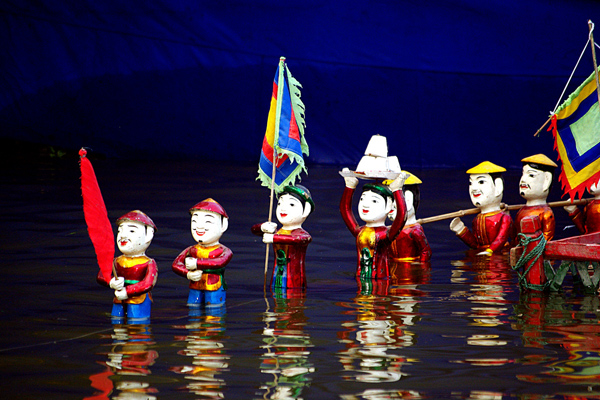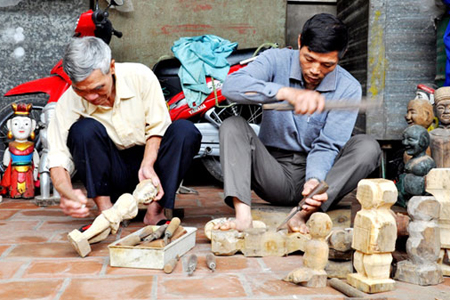Given the fact that the shows take place in water, the puppets must be carved from light, soft, durable wood. Water puppetry, as a rural entertainment, requires inexpensive and easily available raw materials. The fig-tree found at the edges of ponds and lakes is a fairly common feature of the landscapes of Northern Vietnam. It is perhaps due to its very usefulness that this tree is so close to the heart of the Vietnamese peasants; its young leaves can be made into a pig-feed which enriches swine's milk and its fruit is eaten by fish after it falls off the free.
The salted fruit also contributes to the frugal meals of the peasant. Wood from this tree provides ample material for puppet making. The trunk of a five-or-six-year-old fig tree can measure 20-25cm in diameter and needs carving when the wood is still soft and easy to work. Each puppet is between 30cm and 100cm tall and weighs between 1 and 5 kilograms. Simple puppets are made by unskilled workers, meanwhile, in each guild, artisans undertake the task of carving complicated details, which explains why puppets made by different troupes look and are dressed differently. These days professional puppet makers utilize the best techniques handed down by the different guilds and combine this with their knowledge of the human figure. These puppets, however, seeming more sophisticated, have in many cases lost the innocent traits of folk art and the beauty usually found in a more traditional practice. The basic structure of a puppet comprises two sections: the body and the base section.

The Body of Water Puppetry
The body and lower limits are usually made in one piece. The top parts of the upper limbs are fitted with moveable joints to facilitate body movement. The body emerges from the water along with part of the lower limbs, generally being left as one piece. These limbs are usually covered with carved garments similar to those found on statues in communal houses or pagodas. The puppet makers must either have adapted the design of statues found in such places of worship or the creators of such statues must also have taken part in puppet-making.
The Base of Water Puppetry
The base of a puppet is submerged and fitted with a control mechanism that serves as a floating base maintains the balance of the puppet in a vertical position. The size and shape of the base are made to maintain the precise level of submergence. There is little vertical resistance, but the base is subject to significant resistance from the water as it moves forwards, backward, or sideways. Puppets also need to be water-resistant. Resin from the lacquer tree is used to form a coating that keeps them resistant to water as well as wood-boree. After this undercoat of resin come layers or different colored paint to create the characters' costumes or makeup; these are also made from locally-available materials (black lacquer, gold, silver, vermilion, and so on, using traditional techniques for preparing paints from plant resins).



